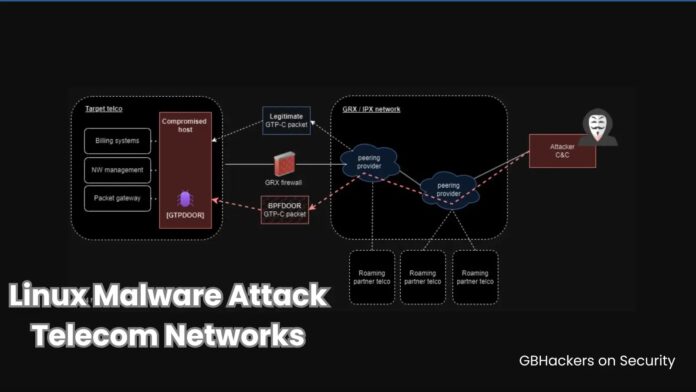[ad_1]
Researchers have discovered a new backdoor named GTPDOOR that targets telecommunication network systems within the closed GRX network, which connects multiple telecommunication network operators.
The GRX network is a closed network that connects individual network operators from various telecom companies.
Network elements like SGSN, GGSN, P-GW, STP, and DRA need direct connections to the GRX network to route roaming traffic, which typically uses the GTP-C protocol for communication.
GTPDOOR is designed to be stealthy and difficult to detect, as it leverages the GTP-C protocol, a legitimate protocol used for communication within mobile networks, to blend in with regular traffic.
It can also modify its process name to mimic legitimate system processes and enhance its ability to evade detection.
Double Agent has observed that GTPDOOR communicates with a command and control server using the GTP-C protocol, which allows GTPDOOR to receive commands from the attackers and send back any stolen data or other information.
You can analyze GTPDOOR malware file, network, module, and registry activity with the ANY.RUN malware sandbox and the Threat Intelligence Lookup that will let you interact with the OS directly from the browser.
Exploring GTPDOOR Functionalities and Versions:
GTPDOOR is a Linux malware targeting telecom networks that uses “magic” packets (GTP-C echo requests) to wake up infected systems, receive commands, execute them, and send results back.

It can be probed remotely, its process name can be changed to evade detection, and XOR encryption can be used for authentication and support key changes.
This malicious software utilizes established protocols and ports to hide within genuine network traffic, making identifying it challenging.
Two malware samples, pickup (enhanced version) and dbus-echo, targeted an outdated Linux system (RHEL 5.x). Their source code suggests poor maintenance by the attacker, and they were uploaded to VirusTotal in late 2023.
Novel GTPDOOR operations:
GTPDOOR utilizes GTP Echo Request messages for covert communication, which listens for UDP packets on port 2123, authenticates messages with a hardcoded key, and decrypts the payload. The message type determines the action:
- 0x03, 0x04, 0x08-0xFF: Execute a shell command and return the output.
- 0x05: Add an IP address/subnet to the Access Control List (ACL).
- 0x06: Get the current ACL.
- 0x07: Clear the ACL.
Version 2 adds:
- Multithreading for handling GTP and TCP communication.
- Liveness checks are performed by responding to any TCP packet with specific flags.
- Forking a process for remote command execution using open().
GTPDOOR v1 offers a range of operations that can be performed on breached hosts:
- Establish a fresh encryption key for C2 communications
- Save custom information to a file on your local system called ‘system.conf’
- Run any shell commands and return the results
GTPDOOR v2 includes additional operations beyond the ones mentioned above:
- Please provide the IP addresses or subnets that are permitted to communicate with the compromised host using an Access Control List (ACL) mechanism.
- Access the ACL list to modify the backdoor’s network permissions as needed.
- Remove ACL to eliminate the malware
Defense and Detection:
System administrators can list raw sockets using tools like “lsof” and “netstat” to look for suspicious entries.
The GPTDOOR handles malformed GTP packets. The following test sets custom client’s GTP protocol type to 0 (GTP prime – charge related). GTP’ fails over GTP-C. Additionally, the extension header is corrupt. The GTP communication includes the encrypted GTPDOOR payload. GTP-capable firewalls can identify and drop anomalous traffic.
Also, processes with abnormal parent IDs or the presence of specific files like “/var/run/daemon.pid” and “system.conf” might cause a GTPDOOR infection.
Network traffic analysis can also reveal signs of malware, as it mishandles GTP packets. Firewalls should be configured to drop inbound packets on ports used by GTPDOOR and block TCP connections not essential for the network.
GSMA has released two (1,2) relevant guidelines for defense.
You can block malware, including Trojans, ransomware, spyware, rootkits, worms, and zero-day exploits, with Perimeter81 malware protection. All are incredibly harmful, can wreak havoc, and damage your network.
[ad_2]
Source link
